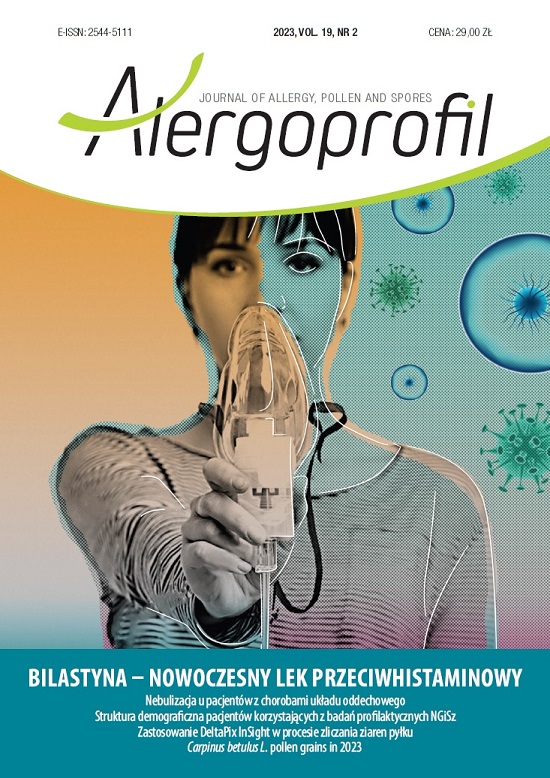Bilastyna – nowoczesny lek przeciwhistaminowy Artykuł przeglądowy
##plugins.themes.bootstrap3.article.main##
Abstrakt
W pracy przedstawiono objawy i najważniejsze zasady postępowania w alergicznym zapaleniu spojówek, alergicznych nieżytach nosa i pokrzywkach. Przypomniano najważniejsze właściwości bilastyny – nowoczesnego leku przeciwhistaminowego II generacji stosowanego w terapii schorzeń alergicznych.
Pobrania
##plugins.themes.bootstrap3.article.details##

Utwór dostępny jest na licencji Creative Commons Uznanie autorstwa – Użycie niekomercyjne – Bez utworów zależnych 4.0 Międzynarodowe.
Copyright: © Medical Education sp. z o.o. This is an Open Access article distributed under the terms of the Attribution-NonCommercial 4.0 International (CC BY-NC 4.0). License (https://creativecommons.org/licenses/by-nc/4.0/), allowing third parties to copy and redistribute the material in any medium or format and to remix, transform, and build upon the material, provided the original work is properly cited and states its license.
Address reprint requests to: Medical Education, Marcin Kuźma (marcin.kuzma@mededu.pl)
Bibliografia
2. Samoliński B, Sybilski A, Raciborski F et al. Częstość występowania nieżytów nosa w polskiej populacji na podstawie badania Epidemiologia Chorób Alergicznych w Polsce (ECAP). Otolaryng Pol. 2009; 63: 324-30.
3. Samoliński B, Raciborski F, Lipiec A et al. Epidemiologia Chorób Alergicznych w Polsce (ECAP). Alergol Pol. 2014; 1: 10-8.
4. Bogacka E, Groblewska A. Zapalenia spojówek – alergia czy zespół suchego oka? Post Dermatol Alergol. 2009; 26: 372-4.
5. Bogacka E, Górski P, Groblewska A et al. Polski konsensus diagnostyki i leczenia alergicznych chorób narządu wzroku. Klin Oczna. 2008; 110: 219-25.
6. Bogacka E, Groblewska A. Alergiczne zapalenie spojówek. In: Bręborowicz A, Sawiec P (ed). Multimedialny Podręcznik Pediatrii. Medycyna Praktyczna. https://www.mp.pl/podrecznik/ pediatria/chapter/B42.167.9.1. (access: 12.04.2023).
7. Chong-Neto HJ, Rosario C, Leonardi A et al. Ocular allergy in children and adolescents. Allergol Immunopathol (Madr). 2022; 50(Pt 1): 30-6.
8. Bousquet J, van Cauwenberge P, Khaltaev N et al. Allergic rhinitis and its impact on asthma. J Allergy Clin Immunol. 2001; 108(suppl): 147-334.
9. Wilson KF, Spector ME, Orlandi RR. Types of rhinitis. Otolaryngol Clin North Am. 2011; 44: 549-59.
10. Wallace DV, Dykiewicz MS, Bernstein DI et al. The diagnosis and management of rhinitis: an updated practical parameter. J Allergy Clin Immunol. 2008; 122: S1-S84.
11. Bousquet J, Khaltaev N, Cruz AA et al. Allergic Rhinitis and its Impact on Asthma (ARIA) 2008 Update (in collaboration with the World Health Organization, GA2LEN and AllerGen). Allergy. 2008; 63(suppl 86): 8-160.
12. Samoliński B, Arcimowicz M (ed). Polskie Standardy Leczenia Nieżytów Nosa – PoSLeNN. Alergol Pol. 2013; nr specjalny S1: 17-167.
13. Zuberbier T, Aberer W, Asero R et al. The EAACI/GA²LEN/ EDF/WAO guideline for the definition, classification, diagnosis and management of urticaria. Allergy. 2018; 73: 1393-414.
14. Zuberbier T, Asero R, Bindslev-Jensen C et al. EAACI/GA (2) LEN/EDF/WAO guideline: definition, classification and diagnosis of urticaria. Allergy. 2009; 64: 1417-26.
15. Pite H, Wedi B, Borrego LM et al. Management of childhood urticaria: current knowledge and practical recommendations. Acta Derm Venereol. 2013; 93: 500-8.
16. Zuberbier T, Abdul Latiff AH, Abuzakouk M et al. The international EAACI/GA(2)LEN/EuroGuiDerm/APAAACI guideline for the definition, classification, diagnosis, and management of urticaria. Allergy. 2022; 77: 734-66.
17. Groblewska A. Alergiczne zapalenie spojówek. Alergoprofil. 2011; 7: 11-5.
18. Brett P, Bielory BP, O’Brien TP et al. Management of seasonal allergic conjunctivitis: guide to therapy. Acta Ophthalmol. 2012; 90: 399-407.
19. Brożek JL, Bousquet J, Agache I et al. Allergic Rhinitis and its Impact on Asthma (ARIA) guidelines-2016 revision. J Allergy Clin Immunol. 2017; 140: 950-8.
20. Emeryk A, Rapiejko P. Alergiczny nieżyt nosa. Lekarz POZ. 2019; 5: 165-9.
21. Krzych-Fałta E, Samoliński B. Polskie standardy leczenia alergicznego nieżytu nosa. Lekarz POZ. 2016; 2: 58-60.
22. Wise SK, Lin SY, Toskala E et al. International Consensus Statement on Allergy and Rhinology: Allergic Rhinitis. Int Forum Allergy Rhinol. 2018; 8: 108-352.
23. Zuberbier T, Bernstein JA, Maurer M et al. Chronic spontaneous urticaria guidelines: What is new? J Allergy Clin Immunol. 2022; 150: 1249-55.
24. Podder I, Dhabal A, Chakraborty SS et al. Efficacy and safety of up-dosed second-generation antihistamines in uncontrolled chronic spontaneous urticaria: a review. J Clin Aesthet Dermatol. 2023; 16: 44-50.
25. Simons FE, Simons KJ. Histamine and H1-antihistamines: celebrating a century of progress. J Allergy Clin Immunol. 2011; 128: 1139-50.
26. Wise SK, Damask C, Roland LT et al. International consensus statement on allergy and rhinology: Allergic rhinitis – 2023. Int Forum Allergy Rhinol. 2023; 13: 293-859.
27. Do TT, Canty RA, Joshi SR et al. Current and future management of chronic spontaneous urticaria and chronic inducible urticaria. Allergy Asthma Proc. 2023; 44: 3-14.
28. Pawliczak R. Bezpieczeństwo nowych leków przeciwhistaminowych. Terapia. 2012; 4: 60-6.
29. Sadaba B, Azanza JR, Gomez-Guiu A et al. Critical appraisal of bilastine for the treatment of allergic rhinoconjunctivitis and urticaria. Therap Clin Risk Manag. 2013; 9: 197-205.
30. Emeryk A, Rapiejko P, Janeczek K. Leki przeciwhistaminowe II generacji – charakterystyka i najnowsze substancje. In: Emeryk A (ed). Postępowanie w alergicznym nieżycie nosa i pokrzywkach u dzieci. Medical Education, Warszawa 2019: 83-98.

